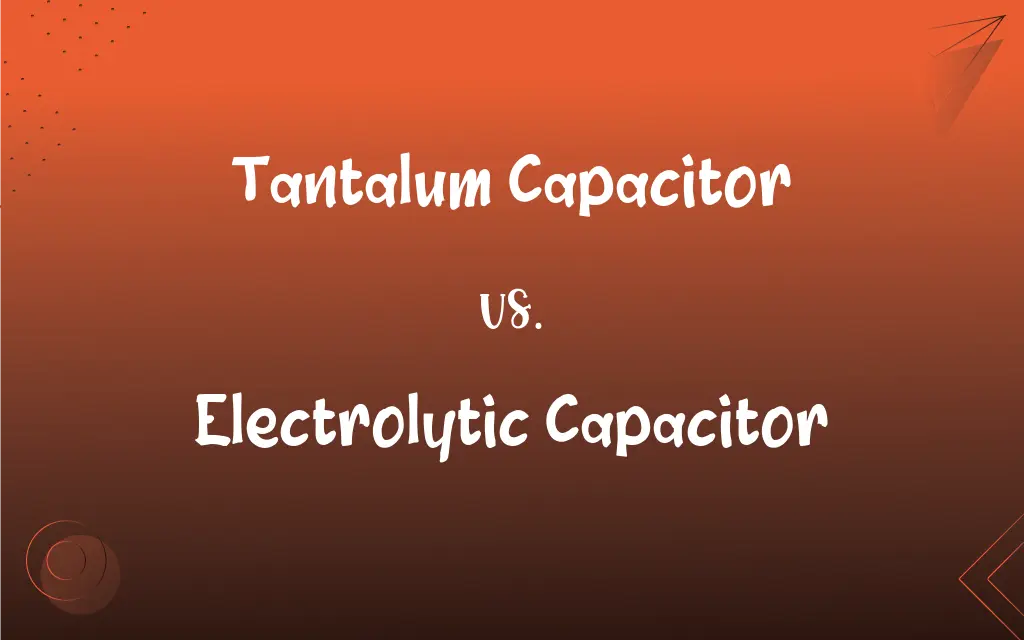Tantalum Capacitor vs. Electrolytic Capacitor: What's the Difference?
Edited by Aimie Carlson || By Janet White || Published on March 8, 2024
"Tantalum capacitors use tantalum for the anode and offer stability and low leakage, whereas electrolytic capacitors use an electrolyte and are larger but cheaper."

Key Differences
Tantalum capacitors are known for their stability and reliability. They use tantalum metal for the anode and are characterized by their small size and low leakage current. Electrolytic capacitors, on the other hand, are larger in size and use an electrolyte as one of the conducting plates, which allows for higher capacitance values but also higher leakage currents.
The construction of a tantalum capacitor involves using tantalum powder to create a pellet, which acts as the anode. This provides excellent stability and frequency characteristics. In electrolytic capacitors, an aluminum or tantalum foil acts as the anode, with the electrolyte serving as the cathode, leading to different electrical characteristics, such as higher capacitance per volume.
Tantalum capacitors are more expensive than electrolytic capacitors but offer better performance in terms of frequency response and thermal stability. Electrolytic capacitors are cheaper and widely used for high-capacitance needs, but they are prone to drying out and have a shorter lifespan, especially in hot conditions.
In terms of applications, tantalum capacitors are preferred in critical and high-reliability applications such as military and aerospace due to their durability and precise performance. Electrolytic capacitors are commonly used in consumer electronics, power supply filters, and audio amplifiers due to their high capacitance and affordability.
Tantalum capacitors have a much lower risk of failure and do not tend to explode when subjected to voltage spikes, unlike electrolytic capacitors, which can fail dramatically under reverse voltage or excessive voltage conditions.
ADVERTISEMENT
Comparison Chart
Anode Material
Tantalum metal
Aluminum or tantalum foil
Size and Leakage
Smaller size, lower leakage current
Larger size, higher leakage current
Cost and Performance
More expensive, higher stability and reliability
Cheaper, higher capacitance, shorter lifespan
Preferred Applications
Critical applications, military, and aerospace
Consumer electronics, power supplies, audio
Failure Risk
Lower risk of failure
Can fail dramatically under certain conditions
ADVERTISEMENT
Tantalum Capacitor and Electrolytic Capacitor Definitions
Tantalum Capacitor
Characterized by low leakage current.
For sensitive electronics, tantalum capacitors provide the necessary low leakage.
Electrolytic Capacitor
Widely used in consumer electronics and audio systems.
Audio amplifiers often use electrolytic capacitors for their high capacitance.
Tantalum Capacitor
Offers superior frequency and thermal stability.
Tantalum capacitors are used in precision audio applications.
Electrolytic Capacitor
Larger in size with higher capacitance values.
Electrolytic capacitors are commonly found in large power filtering applications.
Tantalum Capacitor
A capacitor with a tantalum metal anode.
The circuit design included a tantalum capacitor for its stability.
Electrolytic Capacitor
A capacitor that uses an electrolyte as a cathode.
The power supply circuit uses an electrolytic capacitor for its high capacitance.
Tantalum Capacitor
Preferred in high-reliability and critical applications.
Military communication devices often use tantalum capacitors.
Electrolytic Capacitor
More affordable but with a shorter lifespan.
Electrolytic capacitors are a cost-effective choice for consumer electronics.
Tantalum Capacitor
Known for small size and high reliability.
Tantalum capacitors are favored in space equipment due to their compactness.
Electrolytic Capacitor
Prone to failure in hot conditions or under voltage spikes.
The electrolytic capacitor in the TV failed due to overheating.
FAQs
Are tantalum capacitors polarized?
Yes, they are polarized and require correct polarity during installation.
Can tantalum capacitors tolerate high temperatures?
Yes, they can operate in a wide range of temperatures but have specific limits depending on the series.
What are the common applications of tantalum capacitors?
They are widely used in medical devices, military applications, and smartphones.
How are tantalum capacitors marked for polarity?
Usually, the positive side is marked, but marking can vary by manufacturer.
What are the advantages of using tantalum capacitors?
They are known for their stability, reliability, and excellent performance at high frequencies.
Why are tantalum capacitors considered reliable?
They have a low failure rate and stable capacitance over time and temperature variations.
Can tantalum capacitors be used in audio applications?
They can, but their sound quality characteristics are subject to debate among audio enthusiasts.
What is a tantalum capacitor?
A tantalum capacitor is a type of electrolytic capacitor that uses tantalum metal for the anode.
How does a tantalum capacitor differ from other capacitors?
Tantalum capacitors offer high capacitance per volume, stability, and durability, differing from others in material and performance.
What are the common uses for electrolytic capacitors?
They are used in power supply filtering, audio coupling, and frequency tuning circuits.
Are electrolytic capacitors polarized?
Yes, most electrolytic capacitors are polarized and must be connected correctly.
What are the drawbacks of using electrolytic capacitors?
They are prone to leakage over time, have a limited lifespan, and their performance can degrade at extreme temperatures.
What is an electrolytic capacitor?
An electrolytic capacitor is a type of capacitor that uses an electrolyte to achieve higher capacitance than other types.
Are there non-polar electrolytic capacitors?
Yes, there are special types of electrolytic capacitors that are non-polar and can be installed without regard to polarity.
What happens if a tantalum capacitor is installed backward?
Reverse polarity can cause the capacitor to fail, sometimes violently.
What happens if an electrolytic capacitor is installed backward?
Incorrect polarity can lead to leakage, heating, or even explosion.
Can electrolytic capacitors be used at high frequencies?
They are not ideal for high-frequency applications due to their inductance and resistance characteristics.
How do electrolytic capacitors differ from other types?
They offer higher capacitance values but are generally less stable and have shorter lifespans.
How can you identify the polarity of an electrolytic capacitor?
The negative side is usually marked with a stripe, and the longer lead indicates the positive side.
How does temperature affect electrolytic capacitors?
Their lifespan decreases with increased temperature, and their capacitance can change.
About Author
Written by
Janet WhiteJanet White has been an esteemed writer and blogger for Difference Wiki. Holding a Master's degree in Science and Medical Journalism from the prestigious Boston University, she has consistently demonstrated her expertise and passion for her field. When she's not immersed in her work, Janet relishes her time exercising, delving into a good book, and cherishing moments with friends and family.
Edited by
Aimie CarlsonAimie Carlson, holding a master's degree in English literature, is a fervent English language enthusiast. She lends her writing talents to Difference Wiki, a prominent website that specializes in comparisons, offering readers insightful analyses that both captivate and inform.































































